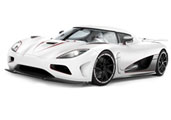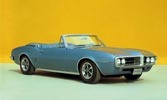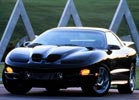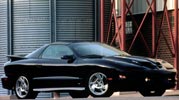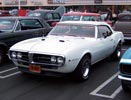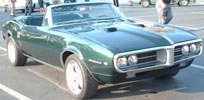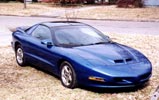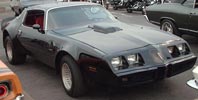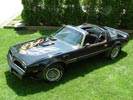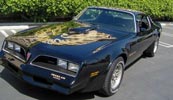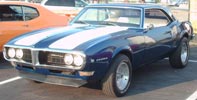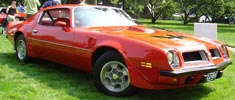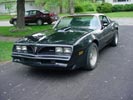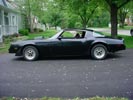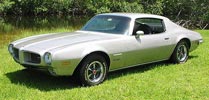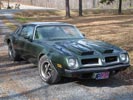The Pontiac Firebird was a pony car built by the Pontiac division of General Motors between 1967 and 2002. The Pontiac Firebird was introduced the same year its platform-sharing cousin, the Chevrolet Camaro. This coincided with the release of the Mercury Cougar, which shared its platform with another well-known pony car, the Ford Mustang.
The vehicles were, for the most part, powered by various V8 engines of different GM divisions. While primarily Pontiac-powered until 1977, Firebirds were built with several different engines from nearly every GM division until 1982 when all Pontiac motors were dropped in favor of corporate motors.
First Generation
The first generation Firebirds had a characteristic "coke-bottle" styling. Unlike its cousin, the Chevrolet Camaro, its bumpers were integrated into the design of the front end and its rear "slit" taillights were inspired by the Pontiac GTO. Both a two-door hardtop coupe and a convertible were offered through the 1970 model year. Originally the car was a "consolation prize" for Pontiac, who had initially wished to produce a two-seat sports car of its own design, based on the original Banshee concept car. However, GM feared such a vehicle would directly compete with Chevrolet's Corvette, and the decision was made to give Pontiac a piece of the pony car market by having them share the F-body platform with Chevrolet. Somewhat disappointed at management's decision, Pontiac went about re-making the F-body in their own image with both styling and engineering changes.
The base model Firebird came equipped with the OHC inline-6 and a single-barrel carburetor. The next model, the Sprint, had a four-barrel carburetor, developing 215 hp (160 kW). But most buyers opted for one of the V8 engines: the 326 in³ (5.3 L) with a two-barrel carburetor producing 250 hp (186 kW); the "H.O." (High Output) engine of the same displacement, but with a four-barrel carburetor and producing 285 hp (213 kW); or the 400 in³ (6.6 L) from the GTO with 325 hp (242 kW). A "Ram Air" option was also available in 1968, providing functional hood scoops, higher flow heads with stronger valve springs, and a different camshaft. Power for the Ram Air package was the same as the conventional 400 H.O., but the engine peaked at a higher RPM. The 230 in³ (3.8 L) engines were subsequently replaced by 250 in³ (4.1 L) ones, the first developing 175 hp (130 kW) using a single barrel carburetor, and the other a 215 hp (160 kW) engine with a four-barrel carburetor. Also for the 1968 model, the 326 in³ (5.3 L) motor was replaced by one with a displacement of 350 in³ (5.7 L). An "H.O." version of the 350 in³ with a revised cam was also offered starting in that year, developed 320 hp. Power output of the other engines was increased marginally. In 1969, a $725 optional handling package called the "Trans Am Performance and Appearance Package,", named after the Trans Am Series, which included a rear spoiler, was introduced. Of these first "Trans Ams," only 689 hardtops and eight convertibles were made. There was an additional Ram Air IV option for the 400 in³ engine during that year, complementing the Ram Air III; these generated 345 and 335 hp respectively. The 350 "H.O." engine was revised again with a different cam and cylinder heads resulting in 330 hp
Second Generation
The second generation debut for the 1970 model year was delayed until February 26, 1970, because of tooling and engineering problems; thus, its popular designation as a 1970 1/2 model, while leftover 1969s were listed in early Pontiac literature without a model-year identification.[1] Replacing the "Coke bottle" styling was a more "swoopy" body style, with the top of the rear window line going almost straight down to the lip of the trunk lid - a look that was to epitomize F-body styling for the longest period during the Firebird's lifetime. The new design was initially characterized with a large C-pillar, until 1975 when the rear window was enlarged. There were two Ram Air 400 engines for 1970: the Ram Air III (335 hp, 366 hp in GTO) and the Ram Air IV (345 hp, 370 hp in GTO) which were carried over from 1969. The difference between the GTO and Firebird engines was the secondary carburator linkage which prevented the rear barrels from opening. Bending the linkage to allow full carburator operation resulted in identical engines. A distinctive, slant-nose facelift occurred in 1977, redone somewhat in 1979. From 1977 to 1981, the Firebird used four square headlamps, while the Camaro continued to retain the two round headlights that had previously been shared by both Second Generation designs. Curb weights rose dramatically in the 1973 model year due to the implementation of 5 MPH telescoping bumpers and various other crash and safety related structural enhancements; SD455 Trans Ams tipped the scale at a whopping 3,850 pounds curb.
The 455 engine available in the second generation Firebird Trans Am was arguably the last high-performance engine of the original muscle car generation. The 455 engine first made its appearance in 1971 as the 455-HO. In 1973 and 1974, a special version of the 455, called the SD-455, was offered. The SD-455 consisted of a strengthened cylinder block that included 4 bolt main bearings and added material in various locations for improved strength. Original plans called for a forged crankshaft, although actual production SD455s received modular iron crankshafts with minor enhancements. Forged rods and forged aluminum pistons were specified, as were unique high flow cylinder heads. A 1967 GTO Ram Air camshaft with 301/313 degrees of advertised duration, 0.407 inch net valve lift, and 76 degrees of valve overlap was specified for actual production engines in lieu of the significantly more aggressive Ram Air IV style cam that had originally been planned for the engine (initially rated at 310 HP with that cam), but proved incapable of meeting the tightening emissions standards of the era. This cam, combined with a low compression ratio of 8.4 (advertised) and 7.9:1 actual resulted in 290 SAE NET HP. The initial press cars that were given to the various enthusiast magazines (e.g., Hot Rod and Car and Driver) were fitted with the Ram Air IV style cam and functional hoodscoops - a fact that has been confirmed by several Pontiac sources although none of those sources are listed here. There is still some controversy about what cam was used in the early press cars due to an article written by Jerry Heasley for Musclecars magazine titled "MEXICAN SHOOTOUT." Mr Heasley did NOT start out with the intention of addressing that question, but in an odd turn of events, he did just that. It all started with a "shootout" between a 1973 SD455 Trans Am and a 1967 440 Dodge Coronet R/T set to take place at the Houston International Raceway in Texas. The R/T backed out at the last minute so Heasley decided to run Mike's 81K mile stock Trans Am for comparison against the times that had been published by Car and Driver magazine back in 1973. Out of three runs, Mike TWICE bettered the times published by Car and Driver, with a best run of 13.75 seconds. While some actual production test cars ran considerably slower and yielded 1/4 miles times in the 14.5 second/98 MPH range in showroom tune - results that are quite consistent for a car with a curb weight of 3,850 pounds and the rated 290 SAE NET HP figure that some sources suggest was "under-rated," High Performance Pontiac magazine dyno-tested an SD and gave it an honest 371 SAE Net rating. Pontiac offered the 455 for a few more years, but tightening restrictions on vehicle emissions guaranteed its demise. Thus, the 1976 Trans Am was the last of the "Big Cube Birds," with only 7,100 units produced with the 455 engine.
The 1974 Firebird Formula, optioned with a 400 in³ engine and 4-bbl carburetor.
In 1974, Pontiac offered an inline-6, a 185 hp 350 in³ V8, and 175 to 225 hp 400 in³ V8 engines. The 455 produced 215 and 250 hp while the SD-455 produced 290 hp. The 400, 455, and SD-455 engines were offered in the Trans Am and Formula models during 1974, but the 400 and 455 engines were the only other options in the 1975 and 1976 models. In 1976, Pontiac celebrated their 50th Anniversary, and a special edition of the Trans Am was released. Painted in black with gold accents, this was the first anniversary Trans Am package and the first production Black and Gold special edition. In 1977, Pontiac offered the T/A 6.6 Litre 400 (RPO W72) rated at 200 hp, as opposed to the regular 6.6 Litre 400 (RPO L78) rated at 180 hp. In addition, California and high altitude cars received the Olds 403 engine, which offered a slightly higher compression ratio and a more usable torque band than the Pontiac engines of 1977.
The 1978 Firebird Trans Am: one of the more popular Second-Generation models
Beginning in 1978, Pontiac engineers reversed years of declining power by raising the compression ratio in the Pontiac 400 through the installation of different cylinder heads with smaller combustion chambers (taken from the Pontiac 350). This increased power by 10% for a total of 220 during the 1978-79 model years. The 400/403 options remained available until 1979, when the 400 in³ engines were only available in the 4-speed transmission Trans Ams and Formulas (the engines had actually been stockpiled from 1978, when PMD had cut production of the engine). 1979 marked the 10th Anniversary of the Trans Am, and a special anniversary package was made available: silver paint with a silver leather interior. The 10th Anniversary cars also featured a special Firebird hood decal, which extended off of the hood and onto the front fenders. In 1979 Pontiac sold 116,535 Trans Ams which still holds the record to this day. In 1980, due to ever-increasing emissions restrictions, Pontiac dropped all of its large displacement engines.
1980 therefore saw the biggest engine changes for the Trans Am. The 301, offered in 1979 as a credit option, was now the standard engine. Options included a turbocharged 301 or the Chevrolet 305 small block.
In the final year of the Second Generation Firebirds (1981), Trans Am still used the same engines as it had in the previous model year, with the only change being the addition of a new electronic carburation system.
Car - Pontiac Firebird
Copyright © 1998-2013 you.com.au

